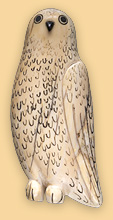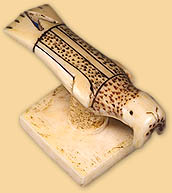 |
Fitzgerald is mentioned in many records regarding the Royal Northwest
Mounted Police because in 1903 he was made the first commander of the
newly established police detachment at Herschel Island in the Western
Arctic. From December 1910 until February 1911, he led a mail patrol
from Fort McPherson southward to Dawson City. When the patrol did not
arrive in time, a search party was sent which found the bodies of
Fitzgerald and the other patrol members. This misadventure has since
been chronicled as the "Lost Patrol."
In 1905, Fitzgerald had met at Fort Resolution with a patrol led by
Dr. George Pearson Bell. On this occasion, he gave Dr. Bell a collection
of artifacts. Among them were "Eskimo Items" which he had most
likely acquired at Herschel Island. In 1975, Dr. Bell's widow sold them
to the Canadian Museum of Civilization.
Reference:
Horrall, S. W.
1973 – Pictorial History of the Royal Canadian Mounted Police.
Toronto: McGraw-Hill Ryerson Limited, pp. 146-149.
North, Dick
1978 – The Lost Patrol. Anchorage: Alaska Northwest Books,
reprinted 1990, 1995.

 |
Owl Pendant, 1903–1905
Collected on Herschel Island, Inuvialuit region
Ivory, baleen, black colouring
7.5 x 3 x 0.5 cm
CMC IV-D-2055
Collected by F. J. Fitzgerald while stationed on Herschel Island as
commander of the Royal Northwest Mounted Police
|
 |
The owl's back is flattened and has two holes at the top to allow
a thread to be pulled through. A small piece of baleen forms a beak.
It is possible that the pieces in Fitzgerald's collection were made
by Alaskan Inuit, employed by whaling ship captains wintering over on
Herschel Island.
Walrus Thread Spool, 1903–1905
Collected on Herschel Island, Inuvialuit region
Ivory, black colouring
2.7 x 4.7 x 2.3 cm
CMC IV-D-2056
Collected by F. J. Fitzgerald while stationed on Herschel Island as
commander of the Royal Northwest Mounted Police
|
 |
 |
The stylized markings on the walrus show Alaskan influence. This
charming figure would have been part of a woman's needle kit. The y-shape
separating the tail feathers would hold the thread in place, while the
spool could be used for winding thread.
Thread Holder, 1903–1905
Collected on Herschel Island, Inuvialuit region
Ivory, black colouring
2 x 13 x 0.6 cm
CMC IV-D-2057
Collected by F. J. Fitzgerald while stationed on Herschel Island as
commander of the Royal Northwest Mounted Police
|
 |
It would not be surprising if this piece was of Alaskan origin. A
similar piece is illustrated in the exhibition catalogue Inua:
The spirit world of the Bering Sea eskimo.* According to the
anthropologist Nelson, it represents a legendary creature. The item
Nelson collected was a socket piece to a sealing dart. Here an almost
identical design has become a utensil for keeping a thread from getting
entangled.
William F. Fitzhugh & Susan A. Kaplan
1982 – Inua: the spirit world of the Bering Sea eskimo.
Washington: Smithsonian Institution Press, ill. p. 44.
Awl, 1903–1905
Collected on Herschel Island, Inuvialuit region
Ivory, black colouring
1 x 12 x 0.5 cm
CMC IV-D- 2060
Collected by F. J. Fitzgerald while stationed on Herschel Island as
commander of the Royal Northwest Mounted Police
|
 |
Awls were used to make holes in a garment before the seamstress pulled
the thread through the material. The indentation on the back of this
creature indicates that it was also used as a spool.
|